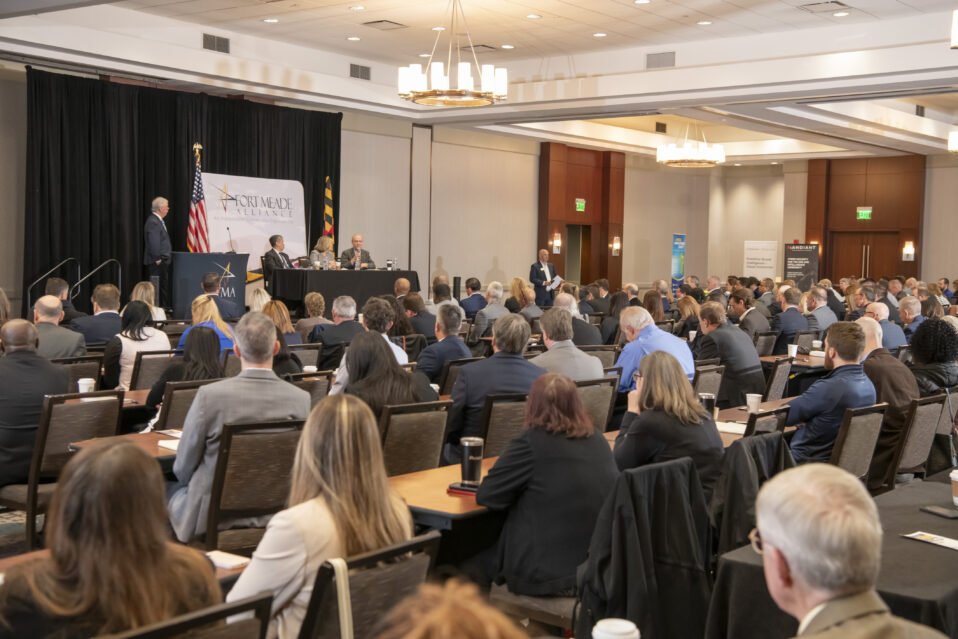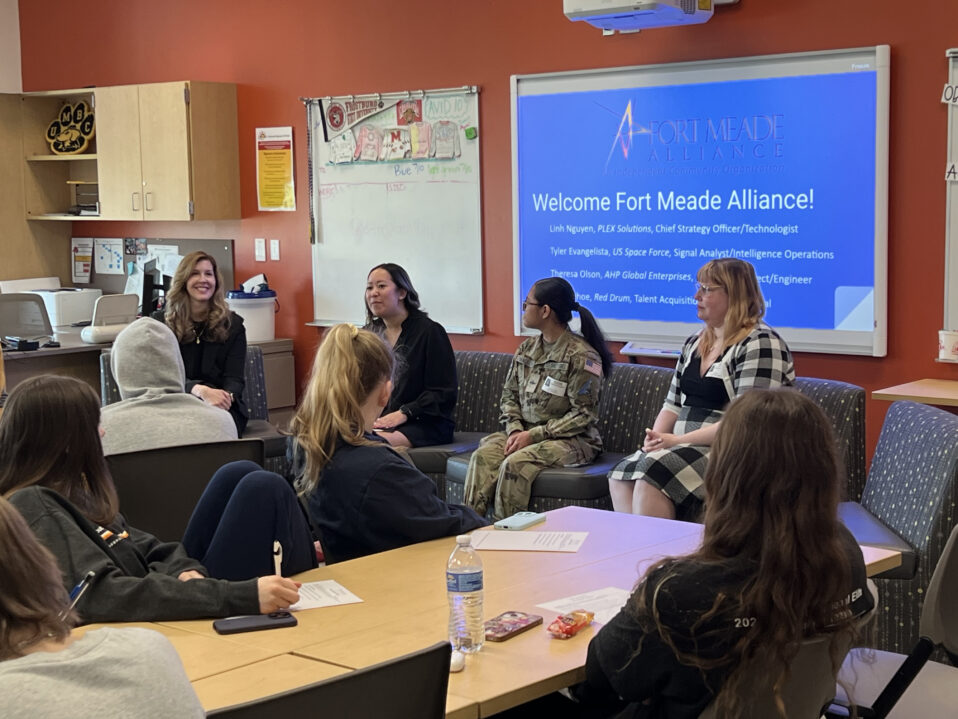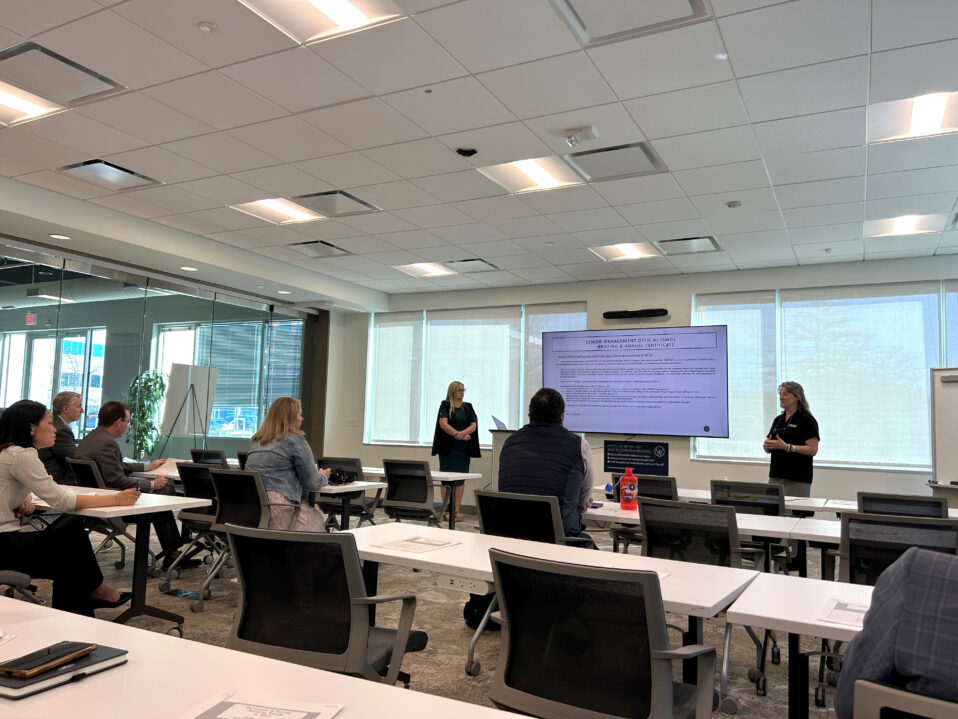 The Fort Meade Alliance recently convened a panel of leaders to discuss available resources to help members interpret and implement the various pieces of federal and state legislation that have recently been passed in response to the COVID-19 pandemic. More than 200 attendees signed on to Tuesday’s webinar.
The Fort Meade Alliance recently convened a panel of leaders to discuss available resources to help members interpret and implement the various pieces of federal and state legislation that have recently been passed in response to the COVID-19 pandemic. More than 200 attendees signed on to Tuesday’s webinar.
Harry Gatanas, former Senior Acquisition Executive with the NSA; Barbara Petilli of Petilli Law; David Stevens, an employment law attorney with Whiteford, Taylor and Preston; and Anne Wagner, President and CEO of the government contactor Wavestrike came together to share their perspectives on the Coronavirus Aid, Relief, and Economic Security (CARES) Act and the Families First Coronavirus Response Act (FFCRA).
Of particular interest to FMA members is Section 3610 and the Paycheck Protection Program of the CARES Act. These sections spell out specific relief measures available to government contractors and small businesses.
According to Gatanas, the concise 23 lines of Section 3610 provides federal agencies powerful authority to modify the terms and conditions of any contract. Specifically covering employees who are denied access to their regular office and who cannot telework, this section allows contracting officers to approve reimbursement for up to 40 hours of paid or sick leave per employee per week, retroactive to January 31, 2020 through September 30, 2020, provided the employer can document the relationship between missed hours and the COVID-19 pandemic.
Though there are currently no published guidelines related to the implementation of Section 3610, Gatanas advised webinar participants to keep detailed records by employee per day regarding hours they were unable to work with dates and relevant reasons why, memos/emails sent to employees with guidance regarding the pandemic, and the number of employees who have tested positive for the virus, if applicable. Contractors should also communicate with their contracting officer to determine if there is any other specific data needed to establish eligibility. Gatanas anticipates that “there is a sense of urgency on the part of everyone to make this happen.” For those affected by the NSA’s 50/50 rule, Section 3610 may provide employers the resources needed to retain their talent throughout this crisis.
The Paycheck Protection Program of the CARES Act is also relevant to employee retention. “It provides a direct incentive for small businesses to keep people on payroll,” said Petilli. The program expands the Small Business Administration (SBA) loan program, directing $349 billion in loans of up to $10 million towards businesses to finance ongoing operational costs, including payroll, rent, interest on other debt and utilities. Businesses that do not cut their payroll during a specific 8-week period can later apply for up to 100% forgiveness of the loan.
According to Petilli, the conditions for small business vary depending on industry. In general, any business, non-profit, veteran’s organization or contractor with 500 or fewer employees will be eligible, while some businesses with more than 500 employees may be eligible depending on their industry and compliance with other SBA conditions.
The amount for which a given business is eligible depends on a formula involving their payroll with a 100K cap per employee, though there is not yet clarity on whether that cap is strictly limited to salary or includes compensation in the form of fringe benefits.
Petilli emphasized that businesses must apply for these loans through their SBA-approved lender rather than through the SBA. She encouraged employers to reach out to their lenders now to begin to confirm if they are SBA lenders or not. If not, businesses will quickly want to find an alternate lender who is approved, as it is possible these funds will go fast.
While the application for this loan is not yet available, those hoping to apply can prepare by gathering documents such as their business and personal tax returns for the last two years, other financial statements and payroll costs for the last 12 months for all employees and 1099 contractors, including retirement and healthcare costs.
Those with 500 or fewer employees should also be aware of new regulations introduced by the FFCRA related to employee leave rights. With the law taking effect April 1, employers will quickly need to determine any new or expanded responsibility they may have for paid leave. Stevens cautioned that individuals should consult their own legal and accounting departments to determine whether they are covered as an employer, whether a specific employee is covered and the rate at which covered leave will be compensated. He said “there is no one-size fits all” model for this statute and some businesses may fit the Department of Labor’s forthcoming guidelines for exemption.
The statute creates two new categories of leave, which have some overlap and compensate eligible employees at different rates. The first category applies to employees who must miss work because they need to care for a minor child whose school or day care facility has closed as a result of COVID-19. This portion of the law expands the Family and Medical Leave Act (FMLA), requiring compliance with this (and only this) provision from even those employers with fewer than 50 employees. Eligible employees may receive up to 12 weeks of leave, with those weeks payable at 2/3 of their total compensation, not to exceed $200 per day.
The Emergency Paid Sick Leave Act, which is the second employee leave provision contained in the FFCRA, provides a two-week leave allotment for other circumstances, including when an employee is unable to work due to the need to self-isolate at the direction of a health care provider, or when the employee is ill with COVID-19 symptoms. Depending on the reason for the leave, the employee could be payable at up to 100% of their regular pay, not to exceed $511 per day.
Stevens cautioned that those familiar with existing FMLA legislation should note that employees on staff for at least 30 days prior to their request for leave are covered by this law. He also cautioned employers to be careful in scheduling exempt employees, who are often eligible for full pay even in weeks where they work fewer than usual hours.
To pay for all of this, Stevens notes that “ultimately, the idea is that any amounts you pay as leave under these two buckets is going to be reimbursable on a dollar for dollar basis.” To take advantage of future reimbursement opportunities, businesses should be sure to keep accurate records of time taken as leave under this statute and the reason why it was needed. Employers are also responsible for posting notice of these new leave rights to employees. The Department of Labor provides a simple PDF that employers can distribute to their employees electronically.
Conclusion
The FMA continues to serve as a resource to members during this rapidly evolving situation. In addition to adding information from this discussion to our website, we are also planning follow-up sessions to delve into these and other topics in more depth. Please feel free to send questions or topics that you would like to see addressed in these future sessions to director@ftmeadealliance.org.



